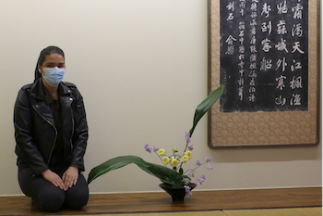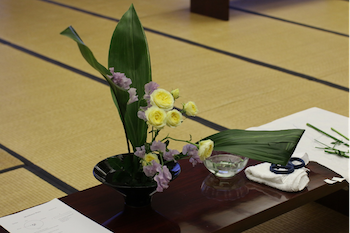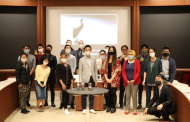Julie Truong, a Global Leader Program (Masters in Management) Class of '22 regular degree student from France, attended the Ikebana cultural experience workshop at the NUCB Undergraduate School campus in Nisshin and detailed her experience in the following report.
Ikebana, or in English, the Japanese art of flower arrangement, is one of the three classical Japanese arts of refinement, along with kōdō for incense appreciation and chadō for the tea ceremony. Those are well-known and they are, for me, the three traditional experiences that a foreigner should experiment with in Japan.
Originated from the ceremonial practice of Shintoism, the Japanese indigenous religion or from the introduction of Buddhism, imported from China in the 6th century, Ikebana was an aristocratic art. The flower arrangement became common in the 15th century with the introduction of Sendensho, the first written text on Ikebana. There are two types of floral arrangement: the traditional one, taught by Ikenobo School in Kyoto, and the modern one.
![Student Voice 2]()
The Ikebana event took place in a washitsu, a traditional tatami room. We were fully immersed in a Japanese environment to develop our creativity. We first learn about the history of this floral art, its complexity and how it became an engagement for life for many people. Practicing Ikebana is not just making a bouquet of flowers. It is more like a sculpture. It required patience and agility.
I am not a very creative person, but what I learned during the practice is that whatever you make, it can turn into something aesthetic and beautiful. The Ikebana event united people from all around the world. We learned some words in Japanese and enjoyed admiring the work of other participants. I think one of the keywords of Ikebana is being curious. Explore the culture, learn about the history, meet new people, exchange through art.

 Brochure
Brochure
 Info Session
Info Session
 Application
Application
 Alumni Voices
Alumni Voices







